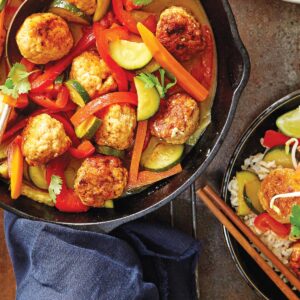
Menstruation is a bodily function as ordinary as any other for women, but often we don’t discuss our periods or even understand what is considered normal.
In a recent Facebook Live session, Healthy Food Guide nutritionist Claire Turnbull and women’s health dietitian Sara Widdowson discussed what normal menstruation looks like and how food can help with problems such as heavy bleeding or painful periods.
What is a normal period?
A normal period occurs every 21 to 35 days (from the first day of one period to the first day of the next), lasting for two to seven days, with around 25ml to 80mls of blood loss, according to Widdowson.
Any blood loss of over 80mls is considered heavy. This would translate as ’10 fully soaked tampons’, she says.
At the onset of puberty and then again during perimenopause (the stage just before full menopause) menstrual cycles may be irregular and unpredictable.
During perimenopause, this is women begin to have more frequent anovulatory cycles, where the ovaries don’t release an egg.
What happens when you don’t ovulate?
The brain urges the release of more of the hormone oestrogen, to make ovulation occur in the perimenopausal woman.
What results are peaks and troughs of oestrogen throughout the menstrual cycle but an overall net loss, contributing to some of the symptoms we are familiar with, such as hot flashes and weight change, Widdowson explains.
Heavy and painful periods
Your first port of call, if you have heavy or painful periods, is your GP or gynaecologist, as there may be a serious underlying condition such as uterine fibroids or endometriosis.
If a more sinister cause of your heavy or painful periods has been ruled out by a qualified medical professional there are some nutrition and lifestyle changes that may help, she says.
What is a painful period?
A painful period is defined as being so painful it prevents you getting on with life. This includes needing to take time off work, having difficulty getting to sleep and relying on pain medication.
Food help for period problems
1 Omega 3 to the rescue
Omega 3 fatty acids, such as those found in oily fish, have anti-inflammatory effects. Omega 3 fatty acids can convert into anti-inflammatory compounds as well as reducing inflammatory ones.
If fibroids, etc, have been ruled out, period cramps may be helped by eating to reduce the prostaglandin compounds that play a role in contracting and expanding the muscles of the uterus.
An omega 3 supplement can help with this, Widdowson says. Eating at least three meals of oily fish, such as salmon or tuna, per week is also a great way to get omega 3.
If period pain is due to endometriosis (a painful condition where uterine tissue grows outside the uterus), omega-3’s anti-inflammatory properties may also help.
Around 95 per cent of people with endometriosis also have irritable bowel syndrome which can aggravate symptoms further. Widdowson uses omega-3 supplementation in her practice to help reduce gut inflammation.
2 Eat iron boosters
Heavy periods can reduce iron levels through greater blood loss, meaning women who have them may be more likely be iron deficient.
The trouble is, iron deficiency also causes heavy periods, so it’s a bit of a vicious circle. Make sure you eat an iron-rich diet, including healthy portions of red meat, a few times a week to keep your levels topped up.
Or, if you’re vegetarian, eat vitamin C containing foods at meals to help the absorption of non-haem iron from plant sources. If you think you have an iron deficiency talk to your GP about getting tested.
3 Eat more, and more widely
One of the common causes of an abnormal menstrual cycle is undernourishment, according to Widdowson.
Menstruation is dictated by hormones and many hormones are derived from fat, she says. Without enough fat in your diet, your body can’t produce the hormones needed for ovulation.
It’s quite common for women to underfuel their bodies, especially when they try diets that cut out whole food groups.
Eating enough food and making sure what you take in includes plenty of colourful fruit and vegetables; good quality carbohydrates (which are essential to ovulation) such as lentils, whole grains and starchy vegetables; healthy fats such as olive oil, oily fish, nuts and avocado; and iron-boosting options such as small portions of red meat, eggs, legumes, green leafy vegetables and tofu.
Sara Widdowson is a Christchurch-based dietitian. To find her or any other member of the Mission Nutrition team head here.
Article sources and references
- Huttington's Outreach Project for Education, at Stanford. Omega-3 Fatty Acids. Accessed 25 June 2020https://hopes.stanford.edu/omega-3-fatty-acids/#:~:text=Studies%20have%20discovered%20that%20omega,a%20greater%20decrease%20in%20inflammation.
www.healthyfood.com










